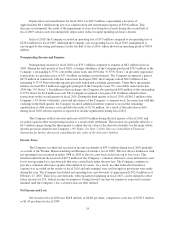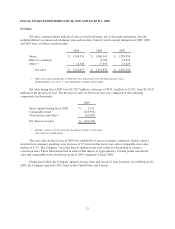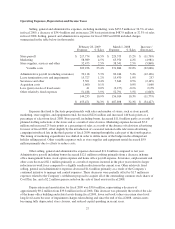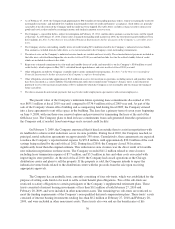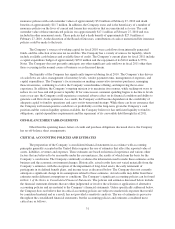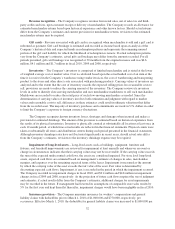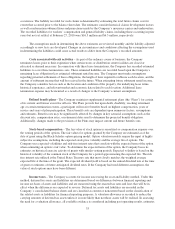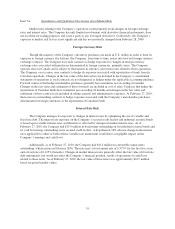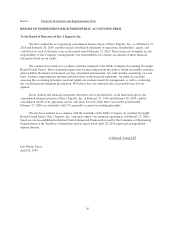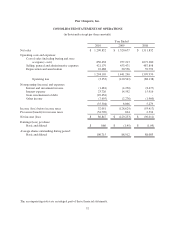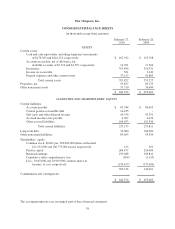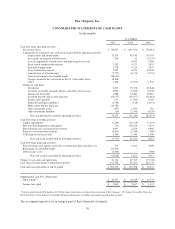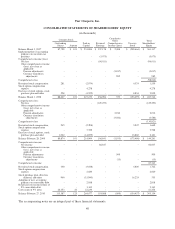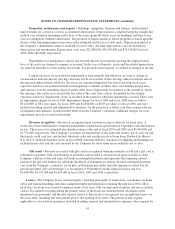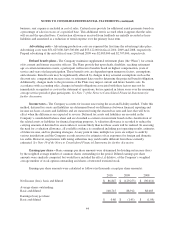Pier 1 2010 Annual Report Download - page 40
Download and view the complete annual report
Please find page 40 of the 2010 Pier 1 annual report below. You can navigate through the pages in the report by either clicking on the pages listed below, or by using the keyword search tool below to find specific information within the annual report.of future income, and tax planning strategies. The Company is subject to income tax in many jurisdictions,
including the United States, various states and localities, and foreign countries. At any point in time, multiple tax
years are subject to audit by various jurisdictions and the Company records reserves for estimates of the tax
exposure for foreign and domestic tax audits. The timing of these audits and negotiations with taxing authorities
may affect the ultimate settlement of these issues. If different assumptions had been used, the Company’s tax
expense or benefit, assets and liabilities could have varied from recorded amounts. If actual results differ from
estimated results or if the Company adjusts these assumptions in the future, the Company may need to adjust its
deferred tax assets or liabilities, which could impact its effective tax rate.
IMPACT OF INFLATION AND CHANGING PRICES
Inflation has not had a significant impact on the operations of the Company during the preceding three
years.
IMPACT OF NEW ACCOUNTING STANDARDS
Accounting Standards Codification
In June 2009, the Financial Accounting Standards Board (“FASB”) issued “The FASB Accounting
Standards Codification and the Hierarchy of Generally Accepted Accounting Principles.” This guidance
establishes the Accounting Standards Codification (the “ASC”) as the single source of authoritative accounting
principles recognized by FASB for all nongovernmental entities in the preparation of financial statements in
accordance with generally accepted accounting principles in the United States (“GAAP”). For SEC registrants,
rules and interpretive releases of the SEC under federal securities laws are also considered authoritative sources
of GAAP. The provisions of this guidance are effective for financial statements issued for interim and annual
periods ending after September 15, 2009. The Company adopted the provisions of this guidance during the fiscal
year ended February 27, 2010 and has updated citations to accounting standards included in the Company’s
financial statements. The adoption of the ASC did not have an impact on the Company’s consolidated financial
position, results of operations or cash flows.
Convertible Debt
Effective March 1, 2009, the Company adopted new accounting guidance, which clarifies that issuers of
convertible debt instruments that may be settled in cash upon conversion must separately account for the liability
and equity components in a manner that will reflect the entities nonconvertible debt borrowing rate when interest
cost is recognized in subsequent periods.
In accordance with this new guidance, the Company estimated the fair value of the debt component of its
6.375% Notes using an income approach by discounting the present value of future payments associated with the
Notes, assuming no conversion features. The Company did not apply the provisions of this guidance
retrospectively on its 6.375% Notes as it determined that the effect on prior periods was not material. The
remaining discount of $2.8 million as of the beginning of the year was reclassified to additional paid-in capital
during the first quarter of fiscal 2010, and was to be amortized as interest expense over the remaining life of the
6.375% Notes, or through February 2011. However, as a result of the retirement and exchange of the majority of
the 6.375% Notes as discussed above, the Company’s gain on the transactions included the write off of a portion
of this unamortized discount. As of February 27, 2010, the remaining unamortized discount related to the 6.375%
Notes totaled $142,000.
Fair Value Measurements and Disclosure
In April 2009, new guidance was issued related to interim disclosures about the fair values of financial
instruments. This guidance requires disclosures about the fair value of financial instruments in interim and annual
reporting periods. The adoption of this guidance has not impacted the Company’s consolidated financial position,
results of operations or cash flows, as its requirements are disclosure-only in nature.
34


